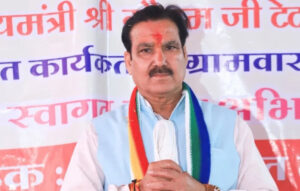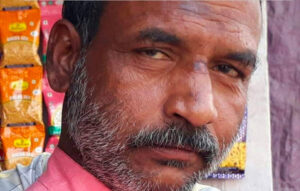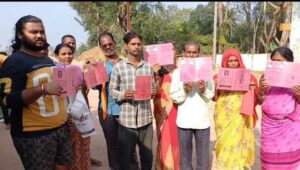Domestic pollution ruining the health of women

( Amitabh Pandey )
Due to increasing cold and dense fog, Suman Bai, 52 years old, woke up from sleep at seven in the morning, a little late. As soon as she got up, after washing her hands and face, she went to the courtyard, picked up the wood, and started lighting chulha in the kitchen. While lighting chulha , she sneezes and coughs, trying to save her eyes from burning smoke. For the past 25 years, Suman Bai, a resident of Kankaria village in Sarangpur tehsil of Rajgarh district, spends about 4 hours every morning and evening in front of chulha spewing smoke for the 12 members of the house.
Now her condition is such that she coughs frequently, becomes short of breath after walking a short distance, and often has a burning sensation in the eyes and sometimes itching in the hands and feet, but Suman Bai says, "This is not a disease but an effect of old age.
How dangerous is this smoke that made Suman Bai ill? The answer is given by Dr. Nivedita Barman, a post doctoral researcher working for the Clean Air Catalyst Project in Indore on behalf of the Environmental Defense Fund. "Particulate matter (PM) 2.5 is one of the major household air pollutants. Biomass (wood, crop residues, etc.) burnt for cooking in conventional chulhas is a major source of PM 2.5. Biomass for cooking, i.e., wood- Indoor air pollution from coal is a serious health hazard. It causes many respiratory diseases and also increases the mortality rate. It can cause cough, asthma, shortness of breath, and stroke in the long run. The risk of lung cancer, heart disease, and other respiratory diseases remains."
It is essential to mention here that the steam from heating oil and ghee while cooking breakfast also contains a mixture of harmful gases. It also enters the body with the breath.According to Dr. Yogendra Srivastava, Medicine Specialist at Jaiprakash Hospital, Bhopal, many harmful gases in oil smoke can cause severe diseases like cancer, TB, and asthma.
It is worth mentioning that in most houses, men do not even know that women become victims of many diseases while working on chulha . The old tradition of cooking food on chulha is continuing in our homes. Environment-related organizations have often expressed concern about the damage caused by this. Even after this, chulha is being used continuously. Families living in villages are using it more than in cities. According to a research report by the World Health Organisation, smoke from chulha can also cause severe diseases like TB and cancer. A report titled Global Burden of Disease states that household air pollution is the second largest cause of most deaths in India. More than one million people die every year due to the smoke coming out of wood, coal, and kerosene in homes and its pollution. According to this report, household air pollution accounts for 25 percent of the total air pollution. According to the 2011 census, 50 percent of the people who use fuel for cooking in India use Firewood, 8 percent use cow dung, 2 percent coal, and 2.5 percent use kerosene.
Continuous use of this type of fuel releases harmful gases like carbon monoxide, nitrogen oxide, and sulfur dioxide. This type of gas has increased significantly in chronic obstructive pulmonary disease (COPD) patients. The most affected by this are women and children. Carbon monoxide is a toxic element that increases the chances of giving birth to low birth weight babies and the risk of miscarriage in pregnant women.
According to 'Multi-Drug Resistant' (MDR) TB specialist Dr. Vishwas Gupta at Madhya Pradesh State Tuberculosis Hospital, the smoke of chulha and the toxic gases in it go inside with the breath. The fine particles dissolved in the smoke are unburnt fuel that accumulates in the lungs in the form of carbon particles. This makes it difficult for the patient to breathe. If there is no timely treatment, the patient's death can also happen.
The Government of India made a provision to provide unrestrained gas cylinders to poor families by implementing the Pradhan Mantri Ujjwala Yojana (PMUY) on May 1, 2016. Please be informed here that a free gas cylinder was also found in Sumanbai's house under the Ujjwala scheme, which is now lying empty in a corner. There are two reasons for this. Firstly, high cost of cylinder, one has to go to the city about 25 kilometers to bring a gas cylinder again and again, and it costs about Rs. 1500, including the rent of Rs. 300-400, to buy the cylinder.
Many women like Hemlata, wife of Arjun Mewada, a resident of Dupadia Bhil village in Sehore district, Sultana, wife of Sheikh Mehmood, a resident of Fakirwada, Sarangpur, cook food on the chulha daily at the cost of their health to save the expenditure on gas cylinders. Arjun Mewada, a farmer by profession, says, "Firewood and cow dung cakes are readily available in the village. With this, they burn chulha without money. According to Sheikh Mehmood, when there is a livelihood crisis due to rising inflation, where will the money be brought to fill the gas tank? Actually, money is spent on something other than lighting chulha by bringing wood from the surrounding forest.
In response to a question asked by Member of Parliament Arvind Dharmapuri in the Lok Sabha on July 21, 2022, Petroleum and Natural Gas Minister Rameshwar Teli said that a total of 80 lakh 83 thousand 142 families in Madhya Pradesh have been provided free water under the Ujjwala Yojana till July 1, 2022. Gas cylinders were given from the side. Among these, 13 thousand 11 such families did not go back to get a refill for the second time.
When MP Shri Dharmapuri, Minister of Petroleum in Lok Sabha, wanted to know whether the government has studied low refills due to rising prices of LPG cylinders? If the answer to this question is yes, what steps have been taken by the government to increase the rate of refills among the beneficiaries of PMUY?
In a written reply to this question of the MP, the Petroleum Minister said that the per capita consumption of PMUY beneficiaries was 3.1 in the financial year 2019-2020, which has increased to 3.66 in the financial year 2021-2022.
Regarding Madhya Pradesh, Member Secretary of the Pollution Control Board, Achutanand Mishra, says that continuous efforts are going on by the government to control domestic pollution. Smokeless advanced chulha is available to eliminate chulha smoke, and emphasis is being laid on increasing its use. Work is underway on a plan to deliver cooking gas through a pipeline to every house in major cities of Madhya Pradesh. Care will be taken to ensure that every section of society gets its benefit.
In a written reply to this question of the MP, the Petroleum Minister said that the per capita consumption of PMUY beneficiaries was 3.1 in the financial year 2019-2020, which has increased to 3.66 in the financial year 2021-2022.
Regarding Madhya Pradesh, Member Secretary of the Pollution Control Board, Achutanand Mishra, says that continuous efforts are going on by the government to control domestic pollution. Smokeless advanced chulha is available to get divested of chulha smoke, and emphasis is being laid on increasing its use. Work is underway on a plan to deliver cooking gas through a pipeline to every house in major cities of Madhya Pradesh. Care will be taken to ensure that every section of society gets its benefit.
Apart from this, the government has taken several steps to promote LPG consumption by PMUY beneficiaries. These include the announcement of a subsidy of Rs 200 per 14.2 kg refill for a maximum of 12 refills per year for the year 2022-2023, an option for a double cylinder connection of 5 kg, an opportunity to replace 14.2 kg cylinder with 5 kg cylinder, up to a maximum of 3 free refills to be given to PMUY beneficiaries under PMGKP from April to December 2020, etc. But despite these announcements, the expected increase in the number of households using gas for cooking in rural homes raises questions about the actual implementation of the schemes. Where will the people below the poverty line get the money to fill gas cylinders every month? While they get wood, cow dung easily free of cost to burn the Chulha.
Lacent, a well-known magazine that provides information about health research, said that in India, an average of one lakh people die annually due to diseases caused by smoke going into the lungs due to cooking on traditional hearths or stoves using wood or other fuel. More people die than However, according to NGOs, this number is much higher. Apart from this, the problem of the environment has also become serious in the country due to the cutting of forest trees. The Central Government had commissioned a study from CRISIL, a survey organization among the general public, on how poor families could be encouraged to cook on LPG? The scheme was implemented without waiting for the results of this study. A month after its implementation, when the results of the study came out, practical flaws were revealed.
A report by the Comptroller and Auditor General (CAG) of the Government of India also confirms this fact. In this report, it was said that in the year 2015-16, households with LPG connections used an average of 6.26 cylinders annually, but after the launch of this scheme, this average fell to 5.6. The study of the impact of subsidy and cost of LPG in the country was also done by an organization called The Energy and Resources Institute. Swati D'Souza, the research officer of this organization, believes that for the success of the Ujjwala scheme, the number of refilled cylinders has to be increased for those living below the poverty line. The price of gas cylinders will have to be kept such that the people of rural areas and poor families do not have any difficulty in paying it. Keeping in mind the social and economic problems of the common man, the prices of gas cylinders will have to be kept minimum, only then people will be able to use the stove at least. Right now, the ground reality of Ujjwala Yojana is that poor, weaker section families cannot continuously use gas cylinders. Its objective was to increase the use of gas by discontinuing the use of a stove to needy families.
Air quality expert Dr. Ajay Nagpure, associated with the Clean Air Catalyst Project, says that people should dispel the illusion that they are not harmed by stove smoke. Women who constantly sit near chulha, their lungs become weak. This also causes a lot of damage to the health of unborn babies and young children.
In the World Health Organization's research report titled Air Pollution and Child Health, it has been told that in 2016, more than 6 lakh children died due to different diseases caused by air pollution in various states of India. 93 percent of the world's children below 15 years of age are forced to live in air pollution of 2.5 PM level. This also includes domestic pollution caused by burning chulha.
There is still a lack of awareness among Indian families regarding domestic pollution. In our country, Chulha is being used in the homes of more than 70 crore people. Sometimes polythene, plastic, paper, old electric wire, and old tyre pieces are also used for lighting chulha. Due to these, domestic air pollution increases. It is worth mentioning that the Madhya Pradesh Pollution Control Board enacted the Air Pollution Prevention and Control Act 1981, but there was not much emphasis on the prevention of domestic air pollution. According to Professor Subhash Pandey, President of the organization named Global Earth Society for Environment Energy and Development, there is no separate clear policy, rule to prevent domestic pollution. For this, such plans will have to be made whose benefits can be taken by the backward and weaker sections of society so that they can stop burning Chulha. For this, they have to be told cheap and alternative solutions. Ashish Trivedi, an advocate of the Madhya Pradesh High Court and an expert on environmental matters, said that no case regarding domestic air pollution has come to my notice so far. The government should make such a policy in collaboration with scientists and subject experts in this regard so that domestic air pollution can be stopped.
It is also essential to know that even in the National Clean Air Program run by the Central Pollution Control Board, more attention is being given to reducing the air pollution of industries than domestic air pollution. Article 21 of the Indian Constitution also includes the right to clean air as a human right. Keeping this in mind, Pradhan Mantri Ujjwala Yojana was started. With this scheme and a reduction in carbon emissions, women's health will also be improved. Justice Narendra Kumar Jain, former chairman of the Madhya Pradesh Human Rights Commission, also believes that the right to clean air is the most prominent human right. Agencies like Central Government and Pollution Control Board will have to work more actively so that everyone can get pure, pollution-free air.
Kaushik Raj Hazarika, project leader of the ongoing Clean Air Catalyst Program feels that Indore administration has done commendable work in solid waste management and involving citizens and sanitation workers lies at the heart of this success. They also need to be sanitized about air pollution and the harmful effects of pollutants on their health. The Catalyst program in close association with the Indore Municipal Corporation has organized a number of air pollution relates awareness workshops in the past. There are plans of more such programs in the coming year, especially targeted at vulnerable stakeholders like sanitation workers. Kaushik feels that such efforts must be sustained over time and continuous.
( This story was produced with the support of Internews’ Earth Journalism Network. )







